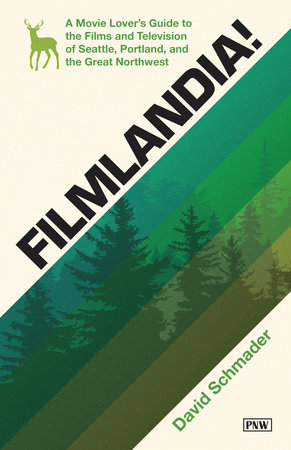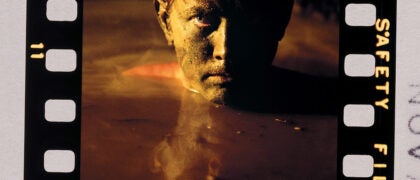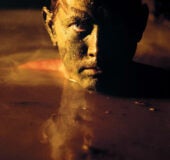Introduction For filmmakers, the Pacific Northwest presents a double whammy of ravishing cinematic locales, offering both hyper-modern cityscapes amid vast natural splendor. Here moviemakers find a reliable setting for all sorts of cloudy human experiences, with the perpetual sog, low skies, and sporadic blasts of light forming a pressure cooker for drama, from love-starved vampires and obsessive con artists to poetic junkies and the nation’s most vengeful divorcees.
But alongside the mossy noirs have bloomed some of the most romantic love stories that still manage to feel like real life, and the whole region has served to cultivate and inspire such world-class cinematic talents as Gus Van Sant, Kelly Reichardt, and Lynn Shelton. Beyond this are the non-cinema visual entertainments—the Frasiers, Portlandias, and Grey’s Anatomies, all drawing on the unique cultural character of the Pacific Northwest.
During initial planning of this book, I assumed I’d be dealing with 80-90 films. But as I worked through those, more and more titles started to trickle in, and in the end I watched over 200. Still, this book is not exhaustive, just alphabetical, with the book’s entries split between Washington (where the primary visual motif is a glistening cityscape before a snow-capped mountain; bonus points for Space Needles) and Oregon (where the primary visual motifs are trees and bridges, bridges, bridges).
Helping me know what I’m talking about is a bunch of other people’s work, from Robert Horton’s 2013 MOHAI exhibit
Celluloid Seattle: A City at the Movies and Michael Upchurch and John Hartl’s archived film writing in the
Seattle Times to filmmakers’ DVD commentaries and the plethora of daily news reports celebrating local movie filmings with a “Hollywood’s coming to town!” featurette. Final thanks to Seattle’s Scarecrow Video, whose vast archives made it possible for me to see even the weirdest title I might have heard of; they can do the same for you.
Sample Entries:
It Happened at the World’s Fair (1963, dir. Norman Taurog)
Fresh out of the military and focusing on his film career, Elvis Presley made 27 movies during the 1960s, nearly all of them corny musical comedies that critics hated and audiences ate up.
It Happened at the World’s Fair is no exception. Presley stars as a freelance cropduster who takes time out of his sexually-harassing-women-from-biplanes schedule to hitchhike to Seattle, where he assumes custody of a stranger’s 7-year-old daughter for a day and together they tour the Seattle World’s Fair. Presley also sings ten whole damn songs, and is perpetually macking on a parade of women who are all hairdos, boobs, and mincing steps. Still, the day at the Fair is pretty thrilling, touring the famous Century 21 exhibit and featuring a reveal of the Space Needle so ravishing you will applaud from the comfort of your own home. Other local delights photographed all Hollywood-pretty: the Monorail, the Seattle Center fountain, and the blue-purple sky over the Sound at dusk.
An Officer and a Gentleman (1982, dir. Taylor Hackford)
Lodged in the collective cinematic imagination for its swoony factory-floor finale set to a soaring “Up Where We Belong,” this tough romantic drama stars Richard Gere as a sailor working his way through the Navy’s Officer Candidate School, Debra Winger as the Puget Sound Debutante who wins his heart, and Louis Gossett Jr. as the gunnery sergeant whose inspired yelling earned him an Oscar. It’s all thoroughly Northwesty, with the bulk of filming occurring in Port Townsend on the Olympic Peninsula, from the training camp at Fort Worden (where the decompression chamber set remains in the building’s basement) to the Tides Motel, where the “Officer and a Gentleman Suite” in which Gere and Winger go bang is available for rent.
Sleepless in Seattle (1993, dir. Nora Ephron)
Nora Ephron’s starry romcom stands so tall as a genre-defining blockbuster that re-encountering its humble actuality is a surprise. In
Sleepless, an eight-year-old imp decides to find his widowed father a new wife. His method: a call-in radio show, through which the father’s tale of eternal love gone too soon is broadcast nationwide, inspiring a raft of amorous correspondence from America’s single women and setting
Sleepless on its sweet, shaggy path toward love found on top of the Empire State Building.
So what makes this thing so lastingly magical? The stars help. Tom Hanks, who’ll spend the years immediately after
Sleepless collecting Best Actor Oscars for
Philadelphia and
Forrest Gump, perfects his patented fractious sweetheart act as a man teetering poignantly between mourning and moving on. Meg Ryan, America’s romcom queen at the height of her reign, brings her fizzy charm and heady intensity to a woman on the verge of having it all, who’s harboring an
ever-growing feeling that there’s something…not necessarily more, just
else. Lording over all is writer/director Nora Ephron, whose wise choices abound, from adhering to a muted color palette and era-generic wardrobe to keep the film visually timeless to engaging the legendary Sven Nyquist—who won international renown and two Oscars for his work with Ingmar Bergman—as cinematographer.
And then there’s the setting. Filmed in late summer of 1992—a season that required producers to fake almost all rain seen on-screen—the movie gives viewers the full Seattle tour, from Pike Place Market (which super-foodie Ephron loved so much she invented an shopping-for-dinner scene to secure its inclusion) to Sea-Tac International Airport, where Hanks’ and Ryan’s high-stakes eye-meet scene was shot at Gate N7 (and where one can purchase
Sleepless in Seattle nightshirts in gift shops). Lake Union is home to Tom Hanks’ incredible houseboat (which sold for over $2 million in 2014), the Athenian Inn at the Market hosts Tom Hanks’ and Rob Reiner’s beloved tiramisu conversation, and West Seattle’s Alki Beach is the destination in a low-speed car/boat chase infamous among locals for its geographical impossibility. (“Throw reality out the window!” says Ephron on the film’s commentary track, cementing her romcom bona fides.)
Apart from all the Seattle locales, our city also served as setting for many non-Seattle scenes, with sets for scenes in Baltimore and New York City—including the finale on the observation deck of the Empire State Building!—built in hangars at the decommissioned Sand Point Naval Air Station.
Fun closing fact: The role of the gloriously deadpan babysitter Clarise was played by Seattleite Amanda Maher, who was discovered waiting tables at the legendary health-food restaurant the Gravity Bar and hired for what is still her one and only film credit, giving a sharp little performance that inspired Nora Ephron to twice declare her “a genius!” on the film’s commentary track.
Sidebar:
Kurt Cobain Nothing retroactively suffuses a life with meaning like suicide, and thanks to his beauty, artistic brilliance, famous wife, and premature end, Kurt Cobain has provided regular inspiration for filmmakers. Here’s the good, bad, and ugly of Cobain cinema.
Kurt & Courtney (1998, dir. Nick Broomfield)
A tabloid-level documentary that strains to float the notion that Courtney Love may have had a hand in the death of Kurt Cobain,
Kurt & Courtney is a garbage parade, full of the flimsiest what-ifs and if-you-say-so mysteries. Still, it looks like a masterwork next to
Soaked in Bleach (2015, dir. Benjamin Statler), another “Was Kurt killed?” rumor puzzle, with
Unsolved Mysteries-quality reenactments and edits so manipulative the film was denounced by its interview subjects. Comedy gold!
Last Days (2005, dir. Gus Van Sant)
Gus Van Sant’s slow, spare feature tracks the decline of a junkie musician whose sock-monkey puppets and soggy blonde locks peg him as Cobain. (Actor Michael Pitt stars, holds a spooky likeness, at least from afar, which a lot of this movie is.) Shot in New York’s Hudson Valley, with film stock treated to suggest the misty PNW, the film wanders to its subject’s inevitable but unseen end, spending time on the minutia—Mormons at the door, a ringing phone always ringing somewhere—that fills the days of a guy on his way out.
Kurt Cobain: About a Son (2006, dir. AJ Schnack)
Cobain is presented via audio of his interviews with Michael Azerrad, author of the Nirvana bio
Come as You Are. Bracing in edited text, here Cobain’s unedited insights come wrapped in his rambling junkie whine, which plays over “corresponding” images of a disorienting randomness. For fetishists only.
Cobain: Montage of Heck (2015, dir. Brett Morgen)
The only Cobain documentary produced with his family’s okay,
Montage makes powerful use of its subject’s art, with Kurt’s ballpoint sketches brought to animated life over alternate takes of his songs. The first half cements the legend of childhood trauma and artistic aspiration, while the second introduces the genius junkie and shitty dad. "The second half, we all ended up hating Kurt,” said Frances Bean Cobain, Kurt’s daughter and executive producer of the doc, to
The Independent. “We were all like, 'You whiny little bitch.’” (For those craving a film experience that captures a Cobain worthy of admiration forever, watch Nirvana’s set on
MTV Unplugged.)
Copyright © 2023 by Schmader, David. All rights reserved. No part of this excerpt may be reproduced or reprinted without permission in writing from the publisher.



















